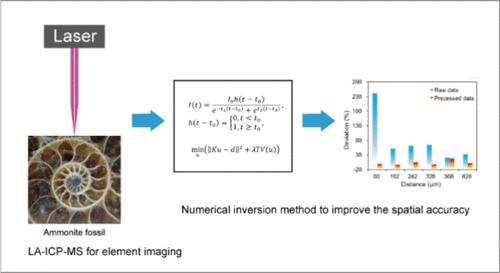提高LA-ICP-MS元素成像空间精度的数值反演新方法
IF 6.7
1区 化学
Q1 CHEMISTRY, ANALYTICAL
引用次数: 0
摘要
激光烧蚀电感耦合等离子体质谱(LA-ICP-MS)的元素成像提供了元素的空间信息,因此可以进一步研究分析物的生长或演化过程。然而,元素分布与质谱信号之间的解耦限制了空间信息的准确测定。当使用高扩散消融电池时,这种现象更为明显,它是由消融和气溶胶输运分散的重叠引起的。利用数学算法重构元素分布是解决这种解耦的有效方法。本研究建立了一种针对LA-ICP-MS中气溶胶扩散和重叠消融独立事件的综合数值反演方法。采用一种新的信号拟合模型和反卷积算法来减轻气溶胶扩散的影响。此外,还开发了边界识别和恢复算法,以解决激光扫描两相界面时相位边界模糊所带来的挑战。通过采用所提出的数值方法,可以以10%的精度测量精细材料的形状,与原始数据相比,这是一个~ 18倍的改进。新算法有望提高LA-ICP-MS元素成像空间分布的准确性,特别是对于仍在全球范围内的微量分析实验室中使用的传统高扩散消融细胞。此外,本文提出的数值反演方法可以应用于各个科学领域,以提高元素成像的质量。本文章由计算机程序翻译,如有差异,请以英文原文为准。

New Numerical Inversion Method to Improve the Spatial Accuracy of Elemental Imaging for LA-ICP-MS
The elemental imaging of laser ablation inductively coupled plasma mass spectrometry (LA-ICP-MS) provides spatial information on elements and therefore can further investigate the growth or evolution processes of an analyte. However, the accurate determination of spatial information is limited by the decoupling between the elemental distribution and mass spectrometry signals. This phenomenon, which is more distinct when high-diffusion ablation cells are used, arises from the overlap of ablation and the transport dispersion of aerosols. Reconstruction of the elemental distribution using mathematical algorithms is an effective approach to addressing this decoupling. This study establishes a comprehensive numerical inversion method that targets the independent events of aerosol diffusion and overlapping ablation in LA-ICP-MS. A new signal fitting model and deconvolution algorithm are employed to mitigate the effects of aerosol diffusion. Moreover, boundary identification and restoration algorithms are developed to resolve the challenges posed by blurring of the phase boundary when the laser beam scans over the two-phase interface. By employing the presented numerical method, the shape of fine materials can be measured with an accuracy of 10%, which is an ∼18-fold improvement compared to the raw data. The new algorithm is expected to enhance the accuracy of the spatial distribution in LA-ICP-MS elemental imaging, particularly for traditional high-diffusion ablation cells, which are still in use in microanalytical laboratories on a global scale. Additionally, the numerical inversion method presented here can be applied across various fields of science to improve the quality of element imaging.
求助全文
通过发布文献求助,成功后即可免费获取论文全文。
去求助
来源期刊

Analytical Chemistry
化学-分析化学
CiteScore
12.10
自引率
12.20%
发文量
1949
审稿时长
1.4 months
期刊介绍:
Analytical Chemistry, a peer-reviewed research journal, focuses on disseminating new and original knowledge across all branches of analytical chemistry. Fundamental articles may explore general principles of chemical measurement science and need not directly address existing or potential analytical methodology. They can be entirely theoretical or report experimental results. Contributions may cover various phases of analytical operations, including sampling, bioanalysis, electrochemistry, mass spectrometry, microscale and nanoscale systems, environmental analysis, separations, spectroscopy, chemical reactions and selectivity, instrumentation, imaging, surface analysis, and data processing. Papers discussing known analytical methods should present a significant, original application of the method, a notable improvement, or results on an important analyte.
 求助内容:
求助内容: 应助结果提醒方式:
应助结果提醒方式:


